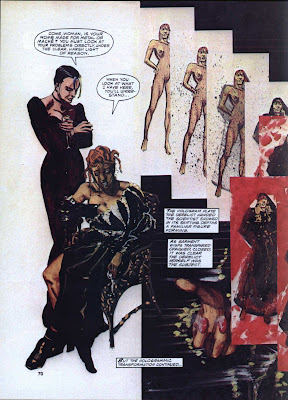Book Review: 'Weird Heroes' No. 1, edited by Byron Preiss
1 / 5 Stars
By 1975 the Nostalgia Craze that had been started by the release of the film Bonnie and Clyde in 1967 had come to be a dominant component of American popular culture.
The time was right for editor and author Byron Preiss to pitch an idea to Pyramid Books: create a lineage of paperbacks designed to mimic the format and content of the old-style pulp magazines of the 30s and 40s.
‘Weird Heroes’ (1975, 256 pp.) was the first of eight volumes that saw print between 1975 and 1977; numbers 1-2, 5 and 8 were anthologies, while the remaining numbers contained a single novel.
The ‘Weird Heroes’ format provided numerous black and white or halftone illustrations with each volume, in keeping with the concept of the pulp magazine layout.
In his Introduction to the first volume, Preiss makes some decidedly pious remarks about avoiding the inclusion of tales featuring overly violent or sexual content, having in mind the men’s action paperbacks that were bestselling outlets for fiction in the 70s: The Executioner, The Destroyer, The Penetrator, etc. ‘Weird Heroes’, he tells us, is designed to showcase tales that evoke the clean, wholesome fun of the pulps.
Unfortunately, Preiss winds up being too contrived in his selection of stories, and the end result is an anthology concept that, in my opinion, misses the mark.
‘Weird Heroes’ starts with a short story by the omnipresent Ron Goulart (Goulart contributes the novel that occupies Weird Heroes #3, as well as a story to Weird Heroes #6). Gypsy, the lead character, is a hip time traveler who arrives in a dystopian London of 2033. It’s not as bad as Goulart’s other efforts at humorous sci-fi, but that’s not really saying much.
Comics writer Archie Goodwin contributes ‘Stalker: the Darkstar File’, featuring a ‘half-breed’ Indian counterculture hero, modeled to a large extent on ‘Billy Jack’ (albeit with longer hair).
With its plotting and prose style adhering pretty closely to the traditional detective story template, ‘Stalker’ is the best entry in the anthology. It provides an interesting look at a portion of the Sun Belt (Oklahoma) at a time when that region of the US was starting to ascend to a more prominent role in the nation's economic and political arenas.
Editor Preiss provides ‘Guts’, the worst story in the collection. Preiss decides to take The Fonz, makes him not an American Jew (i.e., Henry Winkler) but an Israeli Jew (named Mark Gutstein), and sends him back in time to 1976 to prevent Manhattan from being immolated by ‘radiofrenetic material’.
It’s bad enough to base a story on a greaser spouting 50s hipster patter, but Preiss compounds the awfulness by using every Burroughsian, New Wave SF prose contrivance he can think of: chunks of text written in ALL CAPS, pages of dialogue that shift without context from the first- to the third-person POV, scattered epigrams in Hebrew, outrageously arty metaphors (‘Cocoa krispies scream under the pressure of Barrie’s spoon…’) etc., etc.
‘Rose in the Sunshine State’, by JoAnn Kobin, first saw print in 1974 in a feminist literary magazine (?!) titled Aphra. Including ‘Rose’ in ‘Weird Heroes’, editor Preiss solemnly tells us in his Introduction to the story, fits in with the offbeat theme of the anthology and allows for depiction of a hero over 50 years of age.
‘Rose’ is the depressing tale of a 68 year-old woman who lives with her husband, and other Jewish retirees, in a ‘active seniors community’ in Miami. The narrative focuses on the psychology of pending mortality among the aged and infirm. The story is well-written, and I imagine fans of Old Jewish Lady Fiction (think Tille Olsen and ‘Tell Me A Riddle’) will like it, but having ‘Rose’ in ‘Weird Heroes’ is so contrived as to torpedo the whole concept of a pulp-hero inspired anthology.
The next entry in the lineup (and an interlude from fiction pieces), is an interview with Fritz Leiber, conducted by editor Preiss, and focusing on the old pulps. Leiber is less than overwhelmed with nostalgia over the whole pulp era, something that appears to leave Preiss a bit nonplussed.
The final story in the book is Philip Jose Farmer’s ‘Greatheart Silver in: Showdown at Shootout’, an overwhelmingly camped-up story about a former airship pilot who becomes a private detective after being shot down by ‘The Mad Fokker’ (titter).
Greatheart Silver teams up with an elderly incarnation of 'The Shadow' and journeys to Tombstone, Arizona, for the final battle between armies of elderly pulp heroes and villains, all identified with cutesy pseudonyms (e.g., ‘Doc Ravage’, ‘Chimp’, and ‘Porkchop’). Farmer so overdoes his approach to ‘Greatheart’ that the story winds up sinking under the weight of its own smarminess.
‘Weird Heroes’ has very nice illustrations by Alex Nino, Sternako, Dan Sheridan, and Tom Sutton.
The verdict ? ‘Weird Heroes’ has an interesting concept, but Preiss fails to do much with his editorial status, choosing to go with a mostly bland and unremarkable collection of stories. I’ll have to see if ‘Heroes’ # 2 improves on things, but I'm not holding my breath…..
































































.jpg)



















